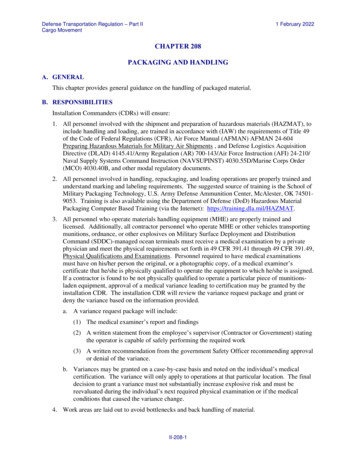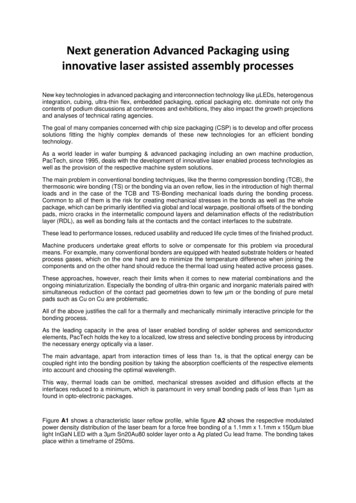
Transcription
Defense Transportation Regulation – Part IICargo Movement1 February 2022CHAPTER 208PACKAGING AND HANDLINGA. GENERALThis chapter provides general guidance on the handling of packaged material.B. RESPONSIBILITIESInstallation Commanders (CDRs) will ensure:1. All personnel involved with the shipment and preparation of hazardous materials (HAZMAT), toinclude handling and loading, are trained in accordance with (IAW) the requirements of Title 49of the Code of Federal Regulations (CFR), Air Force Manual (AFMAN) AFMAN 24-604Preparing Hazardous Materials for Military Air Shipments , and Defense Logistics AcquisitionDirective (DLAD) 4145.41/Army Regulation (AR) 700-143/Air Force Instruction (AFI) 24-210/Naval Supply Systems Command Instruction (NAVSUPINST) 4030.55D/Marine Corps Order(MCO) 4030.40B, and other modal regulatory documents.2. All personnel involved in handling, repackaging, and loading operations are properly trained andunderstand marking and labeling requirements. The suggested source of training is the School ofMilitary Packaging Technology, U.S. Army Defense Ammunition Center, McAlester, OK 745019053. Training is also available using the Department of Defense (DoD) Hazardous MaterialPackaging Computer Based Training (via the Internet): https://training.dla.mil/HAZMAT.3. All personnel who operate materials handling equipment (MHE) are properly trained andlicensed. Additionally, all contractor personnel who operate MHE or other vehicles transportingmunitions, ordnance, or other explosives on Military Surface Deployment and DistributionCommand (SDDC)-managed ocean terminals must receive a medical examination by a privatephysician and meet the physical requirements set forth in 49 CFR 391.41 through 49 CFR 391.49,Physical Qualifications and Examinations. Personnel required to have medical examinationsmust have on his/her person the original, or a photographic copy, of a medical examiner’scertificate that he/she is physically qualified to operate the equipment to which he/she is assigned.If a contractor is found to be not physically qualified to operate a particular piece of munitionsladen equipment, approval of a medical variance leading to certification may be granted by theinstallation CDR. The installation CDR will review the variance request package and grant ordeny the variance based on the information provided.a. A variance request package will include:(1) The medical examiner’s report and findings(2) A written statement from the employee’s supervisor (Contractor or Government) statingthe operator is capable of safely performing the required work(3) A written recommendation from the government Safety Officer recommending approvalor denial of the variance.b. Variances may be granted on a case-by-case basis and noted on the individual’s medicalcertification. The variance will only apply to operations at that particular location. The finaldecision to grant a variance must not substantially increase explosive risk and must bereevaluated during the individual’s next required physical examination or if the medicalconditions that caused the variance change.4. Work areas are laid out to avoid bottlenecks and back handling of material.II-208-1
Defense Transportation Regulation – Part IICargo Movement1 February 20225. All personnel understand and adhere to Occupational Safety and Health Administration (OSHA)requirements.6. All activities that receive, store, issue, or ship material implement procedures for the control,reclamation, and reuse of reusable containers IAW Department of Defense Manual (DoDM)4140.01.C. REPACKAGING1. Transportation operations will not have to repackage material. Repackaging will only be donewhen absolutely necessary.2. If transportation personnel suspect material may require repackaging, contact the installationpackaging and preservation representative. Additional information can be obtained from thepackaging and preservation representatives listed in Table 208-1, Inventory Control Points(ICPs).3. The correct packaging materials and shipping containers must be used.4. Repackaging of HAZMAT material must be performed IAW DLAD 4145.41/AR 700-143/AFI24-210-IP/NAVSUPINST 4030.55D/MCO 4030.40B.D. HANDLING1. Do not remove/tear tape, labels, or other items from any containers, especially fiberboard boxes.2. If an item is dropped or damaged in transit, report it promptly using Transportation DiscrepancyReport procedures IAW Chapter 210.3. Do not put heavy items on top of light items when unitizing loads.4. Packaging and labeling discrepancies are reported using a Supply Discrepancy Report (SDR)IAW DoD 4000.25-M, Defense Logistics Management System (DLMS), Volume II, Chapter 17,Supply Discrepancy Reporting.5. Maintain correct separation and segregation of HAZMAT at all times IAW Air Force JointManual (AFJMAN) 23-209, Storage and Handling of Hazardous Materials.E. MARKING AND LABELING1. Marking and labeling are means of communication identified in MIL-STD-129, AFMAN, 24604, 49 CFR, and other modal regulatory documents.2. HAZMAT labeling must be IAW the modal regulations and clearly visible.3. Do not use local labels unless specifically authorized by the Service/Agency.4. DoD and contractor or vendor shipping activities will apply address markings using a bar codedMilitary Shipping Label (MSL) for all cargo shipments that will enter the Defense TransportationSystem (DTS). This includes shipments moving within the Continental United States (CONUS),between the CONUS and Outside the Continental United States (OCONUS), or converselybetween OCONUS and the CONUS. Shipments originating at non-military facilities moving toor through any DTS node, to include origin, consolidation, transship, a receiving terminal, or atransportation office or supply receiving function will be considered to have “entered the DTS”and must be marked with an MSL. Shipments that will not enter the DTS will have addressmarkings applied as specified by the cognizant activity. Additional information concerning thelatest requirements can be found in the DoD Logistics Implementation Plan for AIT published byII-208-2
Defense Transportation Regulation – Part IICargo Movement1 February 2022the United States Transportation Command (USTRANSCOM) and available via links .a. Military Shipping Label, Generic, Figure 208-1; Military Shipping Label, Personal Property,Figure 208-2; and Military Shipping Label; Unit Move, Figure 208-3; show examples ofacceptable MSLs. Only the exact format shown in Figure 208-4 can be printed and referredto as a DD Form 1387, Military Shipment Label, and it will be used when manual shipmentdocumentation is the only labeling alternative available during emergency operations (whenhand-written labels are the only alternative). With the exception of a hand-written DD Form1387, all shipments entering the DTS are required to be marked with an MSL containing 3 of9 linear bar codes (Code 39) with standard Code 39 characters and a two-dimensional (2D)PDF417 symbol. A specific MSL format is not required; however, keeping the MSL blocknumbers/titles associated with the DD Form 1387 data content is highly recommended. Thespecific orientation and placement of text and bar code symbols are not mandated as long asthe MSL follows the provisions of American National Standards Institute (ANSI) MaterialHandling (MH)10.8.1, subject to the following exceptions:(1) When the capability exists, the MSL label data requirements will be as identified inParagraph J and Table 208-2, Instructions for Completing the MSL.(2) DI codes will not be used in conjunction with the Code 39 bar codes described in Table208-2 (Transportation Control Number [TCN], Piece, Consignee).(3) The MSL unique transport unit identifier will be the TCN and it will be printed in thetop, left, building block of the MSL.(4) DI/DEI codes will be used for the 2D symbols IAW International Organization forStandardization (ISO)/International Engineering Consortium (IEC) 15418 (ANSIMH10.8.2), as implemented by the DoD and shown in Appendix X.(5) The 2D PDF417 symbol syntax will be IAW ISO/IEC 15434 (ANSI MH10.8.3), asimplemented by the DoD and shown in Appendix X.b. Table 208-2 provides requirements for the in-the-clear and Code 39 bar code information onevery MSL. Tables X-2 through X-6 provide requirements for the PDF417 2D symbolgenerated with MSL data, Transportation Control and Movement Document (TCMD) data,and supply information on every MSL using the Data Identifiers (DIs) and Data ElementIdentifiers (DEIs) contained in Appendix X. Linear bar code entries of TCN, piece number,and consignee Department of Defense Activity Address Code (DODAAC) are mandatory, asare the 2D symbol entries for available MSL, TCMD, and supply data. The bar code entriesmust be written to ANSI MH10.8.1 and ISO/IEC 15434 (ANSI MH10.8.3) standards, and inthe-clear entries required by Table 208-2 must be human-readable.c. Detailed procedures for applying shipment marking are specified in MIL-STD-129http://quicksearch.dla.mil/. If the shipping container does not lend itself to application of thelabel, or if the label would cover or interfere with other required markings, the label will beattached to a general purpose tab or a placard. The outside containers of classified orprotected (sensitive) shipments are marked as specified in MIL-STD-129 and the sponsoringService directives, but will not identify the classified or protected nature of the material beingshipped.5. Shipment Unit (SU) documentation to include a packing list, kit list, and line item documents(DD Form 1348-1A, Issue Release/Receipt Document, Figure 208-8, DD Form 1149, Requisitionand Invoice/Shipping Document, Figure 208-9, and DD Form 1150, Requests forIssue/Transfer/Turn-In, Figure 208-10) will be attached to the shipment or packaged with theII-208-3
Defense Transportation Regulation – Part IICargo Movement1 February 2022shipment IAW MIL-STD-129. A copy of the TCMD will also be attached to the shipment, IAWChapter 203, for SUs forwarded to CCPs and for ISO containers.6. Prior to acceptance into the DTS, air mail terminals or designated representatives will ensure thatall United States Postal Service (USPS) mail will have a USPS 135/136 label containing thefollowing information: destination (Aerial Port Code), transportation control number, piecenumber, and weight. Example: OKO, 0235112248x006, pc 4/24, 12 lbs.NOTE: All registered mail will have seal numbers.F. ACTIVE RADIO FREQUENCY IDENTIFICATION (RFID) TAG1. Active RFID tags used by the DoD for documenting shipment units or manifested loads arecommissioned as either a data-rich format or as a license plate format. A data-rich active RFIDtag has shipment data encoded on the tag and the data is sent to the Radio Frequency (RF) InTransit Visibility (ITV) System. A license plate active RFID has no encoded shipment data butthe shipment data is sent to RF-ITV System. Active RFID tags are continuously powered and arecapable of being read at a distance of 300 feet. The management responsibilities, business rules,and data descriptions in the following paragraphs regarding active RFID are applicable to all DoDComponents. They support asset visibility, ITV, and improved logistic business processesthroughout the DoD logistics enterprise.2. Active RFID Management Responsibilities.a. Organizational responsibilities and funding procedures are identified in DoDM 4140.01.b. It is the responsibility of the activity at which containers, consolidated shipments, unit moveitems, or 463L System air pallets are built or reconfigured to procure and operate sufficientquantities of RFID equipment to support the operations.c. If the originating activity of the RFID Layer 4 shipment is a vendor/contractor location, it isthe responsibility of the procuring Service/Agency to arrange for the vendor to attach activetags, either by providing sufficient RFID equipment for the vendor/contractor to meet therequirement, or requiring the vendor/contractor as a term of the contract to obtain necessaryequipment to meet the DoD requirement.d. An organization responsible for port or logistics node operation is also responsible forinstalling, operating, and maintaining RFID capability.e. When responsibility for operating a specific port or node changes (e.g., aerial port operationschange from strategic to operational), the losing activity is responsible for coordinating withthe gaining activity to ensure RFID capability continues without interruption.f.When active RFID devices are used in other than CONUS and U.S. possession locations,DoD Components will forward requests for frequency allocation approval via commandchannels to the cognizant military frequency management office to ensure that RFID tagscomply with U.S. national and OCONUS Host Nation (HN) spectrum management policies.The Army Program Executive Office Enterprise Information Systems (PEO-EIS) AutomatedMovement and Identification Solutions (AMIS) office will assist DoD Components infrequency management issues related to active RFID tags and equipment purchased under theDoD RFID contracts by the AMIS office.g. The USTRANSCOM J4-LT division is responsible for coordinating, establishing, andmaintaining RFID tag formats at the shipment data element level. The active RFID shipmentdata format specification(s), the RF-ITV System interface document for active RFIDtransactions, and the RF device registration and naming convention (for RFID taginterrogator naming convention instructions, see Appendix K) are published by the AMISII-208-4
Defense Transportation Regulation – Part IICargo Movement1 February 2022office and these documents may be accessed via their Web site athttps://national.rfitv.army.mil. After Common Access Card (CAC) login, click on “RF-ITVDocumentation” (at the bottom of the RF-ITV Tracking Portal Home Page).3. Active RFID General Business Rules. The following business rules apply to active tagapplications.a. Commission and/or write active RFID tags for the following categories of DoD-ownedshipments from CONUS to OCONUS, from OCONUS to CONUS, between OCONUSCombatant Commands (CCMDs) or within CONUS in support of North American AerospaceDefense Command (NORAD) and United States Northern Command (USNORTHCOM)operations and exercises.(1) RFID Layer 4 freight container shipments of DoD-owned non-unit related sustainmentor retrograde cargo, as well as sustainment shipments of DoD-owned non-unit relatedmajor organizational equipment not in an RFID Layer 4 freight container.(2) RFID Layer 4 freight container unit move shipments of unit-related cargo, as well asunit move shipments of unit-related major organizational equipment not in an RFIDLayer 4 freight container.(3) RFID Layer 4 freight container shipments of DoD-owned ammunition/explosives.(4) RFID Layer 4 freight container shipments of DoD-owned prepositioned stocks or WarReserve Material, as well as shipments of DoD-owned prepositioned majororganizational equipment not in an RFID Layer 4 freight container. For current afloatassets, RFID tags will be commissioned or written and attached during the normalmaintenance cycle, reconstitution reset, or sooner as required.NOTE: See Part II Definition for Radio Frequency Identification Layer 4. The license platetag commission process is similar to the data-rich tag write process except shipment data isnot written to tag memory.b. Eligible shipment category deviations.(1) Organizations may employ the use of active RFID technology for intra-CONUSshipments to support operations or for training. (NOTE: The use of RFID technology ismandatory for intra-CONUS shipments/deployments in support of NORAD andUSNORTHCOM operations and exercises.) Organizations desiring the DefenseLogistics Agency (DLA) to provide RFID tag support for intra-CONUS shipments willformally work the requirement through the DLA Performance Based Agreementprocess. Users should be aware that the sustainment format for the RFID tag is based onOCONUS shipment Advance Transportation Control and Movement Document(ATCMD) information. CONUS commercial bills of lading do not generate the sameshipment data content. Data inquiry and data transfer utilities relying on an ATCMDdata structure may not perform as expected.(2) Shipments with a human escort or requiring signature service such as currency, courier,and U.S. mail do not require an active RFID tag.(3) Shipments from the following specific organizations do not generally require an activeRFID tag: Army and Air Force Exchange Service, Navy Exchange Service Command,Marine Corps Exchanges and Defense Commissary Agency, and Defense LogisticsAgency Prime Vendor Program.(4) Ammunition stocks to be consumed while afloat must not be tagged.II-208-5
Defense Transportation Regulation – Part IICargo Movement1 February 2022(5) Self-deploying aircraft and ships and the organic materiel they carry do not require anactive RFID tag.(6) By exception, any shipment or cargo type may be required to have an active licenseplate tag or active data-rich tag attached if the CCMD requests it for a specificoperational requirement and the Joint Staff Logistics Directorate (J4) and AssistantDeputy Under Secretary of Defense (Supply Chain Integration) (ADUSD [SCI]) supportthe request.(7) An RFID tag is not required for unit move cargo where the Joint Operation Planning andExecution System (JOPES)-identified port of debarkation (POD) and the destination arethe same.(8) Active RFID tags are not required for sustainment/retrograde “port-to-port” built palletsand rolling stock. A “port-to-port” built pallet/rolling stock is defined as a pallet (singleor multi-train) or rolling stock that originated (pallet ID assigned) at an APOE andterminated (pallet ID deleted) at an aerial POD (APOD).(9) Sustainment cargo (pallets/rolling stock) destined for locations not supported by RFIDinterrogators do not require RFID tags (e.g., North Pole).c. The tags will be attached at the point of shipment origin for all activities (includingvendors/contractors) that stuff containers or build pallets (e.g., 20- or 40-foot ISO containers,463L pallets, and other large reusable containers [e.g., containers used to convey large itemssuch as engines or transmissions]), or activities that ship unit move or prepositioned majororganizational equipment.d. Active RFID tag-related shipment data (see Appendix K) must be sent to the RF-ITV Systemmaintained by the Army AMIS office (https://national.rfitv.army.mil). Tag ID and sensorstatus (as applicable) information obtained during in transit tag interrogation is automaticallysent to the RF-ITV System.e. When an RFID Layer 4 shipment is reconfigured during transit, the accompanying activeRFID tag must be written to reflect the reconfigured shipment data and the new data recordsent to the RF-ITV System.4. Active RFID Tag/Accessory Issues and Returns.a. The primary method to acquire active RFID tags is through the normal supply requisitioningprocess from DLA. Active RFID tags may also be purchased directly through the AMISRFID contract (see http://www.usarmyamis.army.mil).b. Active RFID tags are designed for reuse and will function properly over many years ofrepeated use. Periodic battery replacement will be required depending on frequency of useand number of interrogations.c. The legacy active RFID tags migrated from the ANSI INCITS 256 standard protocol to theISO/IEC 18000-7 standard protocol. As of 1 Jan 2015, only ISO tags will be used to meetDTR requirements. Contact the AMIS office for source information if dual-mode capable(ANSI/ISO) infrastructure equipment is required.d. Serviceable ISO tags (condition code A) and restorable ISO tags (condition code E/G) excessto operational requirements should be returned to collection points identified by the Service,CCDR, or Defense Agency for reuse IAW standard operating reuse/return procedures.Collection points should be resourced to refurbish restorable ISO tags (i.e., replace batterycaps and/or batteries) to fully serviceable status (condition code A). ISO tags (condition codeA/E/G) excess to geographical retail requirements should be reported to the DoD ItemII-208-6
Defense Transportation Regulation – Part IICargo Movement1 February 2022Manager and shipped as per instructions. Activities are encouraged to use this DLMSMateriel Returns Program (MRP) process to return ISO tags (condition code A/E/G) nolonger required and receive reimbursement for Packaging, Crating, Handling, andTransportation (PCH&T) costs.(1) The PCH&T reimbursement incentive for serviceable/restorable ISO tags received withMRP transactions will result in reduced costs and savings to the DoD. Distributioninstructions will be provided telling activities where to send tags reported as excess tothe ICP.(2) Serviceable/restorable ISO tags sent back without MRP transactions will not result inPCH&T reimbursement to the customer; however, they will be reused and result insignificant reduction in cost to the DoD. The ISO tags returned without MRPtransactions may be sent to either of the following addresses:SW3100Transportation OfficerDDSP New Cumberland FacilityBuilding 2001 Mission Door 113-134New Cumberland, PA. 17070-5002SW 3224DLA Distribution San JoaquinReceiving Warehouse 5725600 South Chrisman RoadTracy, CA 95376-5000(3) All ANSI tags and physically damaged ISO tags should be turned in with properdocumentation (e.g., DD Forms 1348-1A or 1149) to the nearest DLA DispositionServices Office (unless directed otherwise by competent authority). Customers willreceive no reimbursement for this turn-in.e. The Services, other requisitioners, and users may opt to establish their own retail operationfor used RFID tags and incur the cost of refurbishment themselves.5. Active RFID Tag Use.a.RFID Tag Management. RFID tags are an item of supply that will be used IAW DoD,Service, and/or Geographical CDR issuances. However, since they are a necessarycomponent of the DoD’s ITV capability, there are business process requirements which willbe followed in order to ensure the RFID infrastructure reliably reports ITV information.(1) Active RFID tags are designed for reuse and DoD Components are responsible for tagmanagement and reuse, regardless of the method they are acquired.(2) The tags will be operationally checked prior to each use (the tag will beep when thebattery is installed to indicate the power is on).(3) If a tag is written in a location other than the location where it will be attached to ashipment, the tag may need to be deactivated (battery polarity reversed) during itsmovement to the cargo attaching site to preclude false reporting of shipment location.Deactivating the tag does not erase the data stored in the tag.(4) When a shipment is terminated/delivered or the tag is stored, the tag must be deactivated(battery polarity reversed) to preclude false reporting of tag assignment or shipmentlocation.(5) The ISO/IEC 18000-7 format tags (identified with a 14-digit ID number on the tag label)are commissioned/written using a USB cable and/or via RF transmission depending onthe tag version (e.g., license plate tags are RF only).(6) After an RFID tag is commissioned/written, the complete RFID shipment data generatedfor the RFID process will be sent to the RF-ITV System before the cargo beginsII-208-7
Defense Transportation Regulation – Part IICargo Movement1 February 2022movement. If this is not done, the RF-ITV System may report the tag’s newmovement/locations for cargo data previously written to the tag file.b. RFID Tag Mounting on Shipments(1) The electrical connection port on the tag will be covered with the rubber cap unlessbeing accessed for tag processing.(2) The tag ID number and its related bar code will not be obscured by user applied labels.(3) The tag battery compartment will not be covered with a label such that it cannot beopened to access the battery.(4) Tags will be secured to the shipment with the optional commercial mounting brackets,magnetic mounts, or with two high-strength plastic/wire tie straps (each with at least 10pounds of tensile strength – recommended are 50-lb tensile strength plastic tie straps).The use of high-strength tie straps is especially important for tags secured to the exteriornetting of 463L System air pallets.(a) Tags secured to unpackaged equipment, equipment in ISO flat racks, or 463LSystem pallet netted loads will be secured in a visible location close to the MSL, iflabeled, or the pallet ID placard.(b) Tags that are tied/strapped to the exterior surface of ISO containers or RO/ROtrailers will be attached to the vertical, locking door bar (above the locking handleso as not to interfere with its operation) on the left rear door (facing the container) –the right door is usually opened for inspection/customs access. When possible, putthe tag under or between the vertical locking bars in a corrugated channel. The tagwill be attached so it never extends above/beyond the exterior surface or an exteriorprotrusion of the container to such a degree that the tag may get scraped off whenloading the container into a ship’s stow cell. Tags that are attached to containerswith magnetic mounts must also be securely fastened to the magnetic fixture. Tagsdesigned with special mounting features will be attached IAW their applicationinstructions.(c) Tags constructed in a “C” clamp form (e.g., ST-675-I) so as to be placed onto theleft door of an ISO 668: 1995(E) Series 1 freight container will only be used forthat purpose.6. Active RFID Shipment Data Content-Level Detail (see Table 208-3). If the active RFID tagshipment content-level detail data is considered mission essential or conditional (see AppendixK), the data is sent to the RF-ITV System and also encoded in the RFID tag. For license plateRFID tags, the shipment content-level detail data is only sent to the RF-ITV System and is notencoded in the RFID tag.a. Shipment content-level detail includes the asset detail data elements that describe the assetplus the cargo detail data elements necessary to minimally identify and handle each level of acomplete shipment entity, which is a single shipment unit, a consolidated shipment unit, or amanifested load. The most basic shipment entity is a single box or unpacked item markedwith a shipment unit identifier.(1) Asset detail is the fundamental information necessary to describe the physicalcharacteristics of a single asset and the characteristics that identify that asset.(2) Cargo detail describes the accountable characteristics of the included assets, the physicalcharacteristics of the packaged shipment, and the respective cargo identifiers andhandling characteristics.II-208-8
Defense Transportation Regulation – Part IICargo Movement1 February 2022b. The content-level detail data may be obtained from requisition documents, shipment statustransactions, Advance Shipment Notice (ASN) transactions (ATCMD, manifest, shipmentstatus, and MILSTRIP status information), consolidated shipment notice transactions, theTCMD, and commercial carrier transactions.c. The content-level detail TCN generated for RFID Layer 4 freight containers may be derivedfrom TCMD header records, manifest header information, or the MSLs that mark the cargo.The TCN for consolidated movements has several colloquial titles such as: lead TCN, headerTCN, prime TCN, or conveyance TCN. The TCN is unique and not duplicated bysubordinate TCNs within the consolidation or unitized load.NOTE: The active RFID shipment data requirements at Appendix K are the legacy and currentdata formats structured to accommodate legacy and new RFID tag capabilities. The active RFIDdata requirements will be updated to include the content-level detail data listed in Table 208-3 asRFID tag capabilities are upgraded and data becomes available in supporting systems.7. Active RFID Shipment Data TCMD Detail. The active RFID shipment data requirements atAppendix K include a requirement to encode shipment unit or manifest TCMD recordinformation using the DLSS MILS 80-column format. If the TCMD information is in a formatother than the DLSS MILS format, it cannot be encoded on the tag or sent to the RF-ITV System.a. TCMD entries are conditional data (must be provided if available).b. The MILS 80-column format is being phased out by the DoD, but some or all of the TCMDdata elements remain as critical information required for supply chain processing. TheTCMD element information in the RFID tag memory or in the respective RFID shipment dataon the RF-ITV System are now used by transshipper activities to pre-lodge advance shippingdata into their automated information systems when ATCMD information is not available.c. Table 208-4 identifies the TCMD detail data elements (which are in addition to the contentlevel detail elements identified in Table 208-3) that may be available within an active RFIDtag.d. Unit move shipments: When the capability exists, the transportation tracking number (TTN)generated by shipping applications that support unit movements for each shipment unit willbe encoded in the tag data file as User Defined information. See Appendix K, Table K-6.The TTN is a conditional element that must be encoded if it exists for the shipment identifiedwith a ULN. The TTN cannot be changed once generated for a specific shipment unit. TheTTN associated with the lead TCN for the active RFID tag will also be sent to the RF-ITVSystem.8. Active RFID Transactions.a. RFID shipment data files and interrogator reads will be generated and forwarded to the RFITV System IAW established DoD data timeliness guidelines published in this regulation (seeTable 202-2, Timeliness Evaluation Criteria) and the Joint Publication 4-01, Joint Doctrinefor the Defense Transportation System, in-transit visibility reporting requirements.(1) The complete RFID shipment data will always be sent to the RF-ITV System, even incases where the RFID shipment data is generated for a data-ric
A license plate active RFID has no encoded shipment data but the shipment data is sent to RF-ITV System. Active RFID tags are continuously powered and are capable of being read at a distance of 300 feet. The management responsibilities, business rules, and data descriptions in the following paragraphs regarding active RFID are applicable to all DoD











